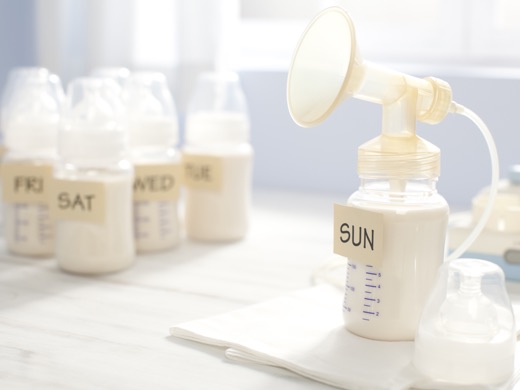Breastfeeding Support 24/7: 855-550-6667
Supply & Demand
Since each mom and baby is different, breastfeeding can be different for each mom and baby pair. The first hours, days, and weeks of breastfeeding determine how much milk your body will make. It’s as if your baby is placing her order for the amount of milk she will need to grow. Each time you breastfeed, you’re telling your body to make more milk.
Pregnancy: Your Body Knows What to Do
There is nothing you need to do to prepare your breasts for breastfeeding. Your body started getting ready to make milk almost as soon as you became pregnant. Signs that your body is preparing for breastfeeding include:
- Sore, tender breasts
- More or darker veins on your breast
- Darkening areola
- Increase in breast size
By around 16 weeks pregnant, your body has already begun making colostrum, or newborn milk, so it will be ready when baby is born. Some pregnant women may notice colostrum leaking, and some may not. Whether or not you leak has nothing to do with how much milk you will make for your baby.
The More Often You Breastfeed, the More Milk You Will Make
Whenever your baby breastfeeds, a hormonal signal is sent to your brain to make milk. The more often your baby breastfeeds, the stronger the hormonal signal. And the more milk your baby takes, the more your body makes! This is why mothers of twins can make enough milk for both babies. Two babies breastfeeding on two breasts are sending double the hormonal signal, and the result is a double milk supply.
The opposite is true, too—the less often you breastfeed, the lower your milk-making hormones and the lower your milk supply will be.
Tips for Building a Strong Milk Supply
- Breastfeed or hand express your colostrum in the first hour if possible, or as soon after delivery as you can.
- Nurse your baby whenever she is hungry. You can expect your newborn to eat 8 to 12 times every 24 hours.
- Hunger cues include bringing hands to mouth, making tongue or mouth movements, or searching for your breast. Breastfeed your baby as soon as you see these hunger cues.
- Avoid timing feedings, as this may limit baby’s intake and cause your supply to decrease. Allow your baby to end every feeding by coming off the breast on her own. Let them signal when they are done.
- It’s important for milk production that your baby is latched deeply. Painful breastfeeding is a sign that your latch needs adjusting, and if not addressed, it may cause a decrease in your milk supply.
- If your baby is having trouble latching or the latch is very painful, ask a WIC lactation consultant for help or call the free, 24/7 Texas Lactation Support Hotline at 855-550-6667.
- If using a breast pump, it is important that your pump fits well. Pain when pumping is a sign that the flange size or suction may need to be adjusted. Your WIC office can help ensure the flange size and suction are right for you.
Watch our video to learn how to get started setting your milk supply.
Using Bottles and Pacifiers
In the first few weeks after birth, the more often your baby is nursing at the breast, the more milk she will get and the better your supply will be. When a baby is sucking on a bottle or pacifier, your body is not getting the hormonal signal it needs to make milk, which may decrease your supply over time.
To maintain a full milk supply, pump or hand express your milk each time you offer a bottle. Pumping or hand expressing in place of breastfeeding works the same way a baby does to build your milk supply.
If you choose to use a pacifier, try to limit its use in the first few weeks until breastfeeding is well established.
How do I know my baby is getting enough milk?
There are three ways to know your baby is getting enough to eat:
- She is back to her birthweight by 2 weeks old.
- She shows hunger cues 8 to 12 times every 24 hours, breastfeeds well, and then appears satisfied at the end of each feeding.
- She has wet and dirty diapers that match up to the diaper chart.
Watch this video to learn more about how to know your baby is getting enough to eat.
Setting Your Supply FAQ
Do I need to pump in addition to breastfeeding to make a full milk supply?
No. If your baby is breastfeeding well, there is no need to pump. Pumping in addition to a baby who is breastfeeding well, makes your body think that you have twins. Too much milk, or oversupply, can cause many problems for both mom and baby.
What if I think I have a low milk supply?
If your baby has a low diaper count, or your health care provider is concerned about your baby’s weight, you might have a low milk supply. But it’s also possible you have plenty of milk and your baby just isn’t breastfeeding efficiently.
A lactation consultant is the best person to help you figure out what is going on with your milk supply. The Texas Lactation Support Hotline offers free 24/7 help from lactation consultants: 855-550-6667. Find other ways to get help with latching, breastfeeding positions and all your breastmilk supply questions.
How much water do I need to drink when I’m breastfeeding?
As a breastfeeding mom, you might feel thirstier than you used to. There is no specific amount of water you need to drink while breastfeeding. We recommend drinking every time you feel thirsty so that you stay hydrated. Caring for a newborn can be challenging, and it’s common for moms to forget to drink fluids throughout the day. Try keeping a refillable water bottle wherever you sit down to breastfeed or pump. This way, you can drink from it every time the baby needs to eat.
Are there specific foods I need to eat?
It’s a myth that breastfeeding moms need to eat specific foods or maintain a perfectly healthy diet to breastfeed their baby. Regardless of what you eat, your body will always make nutritious milk for your baby. It is always a good idea to eat a variety of nutritious foods throughout the day. Learn what to eat during and after pregnancy.




